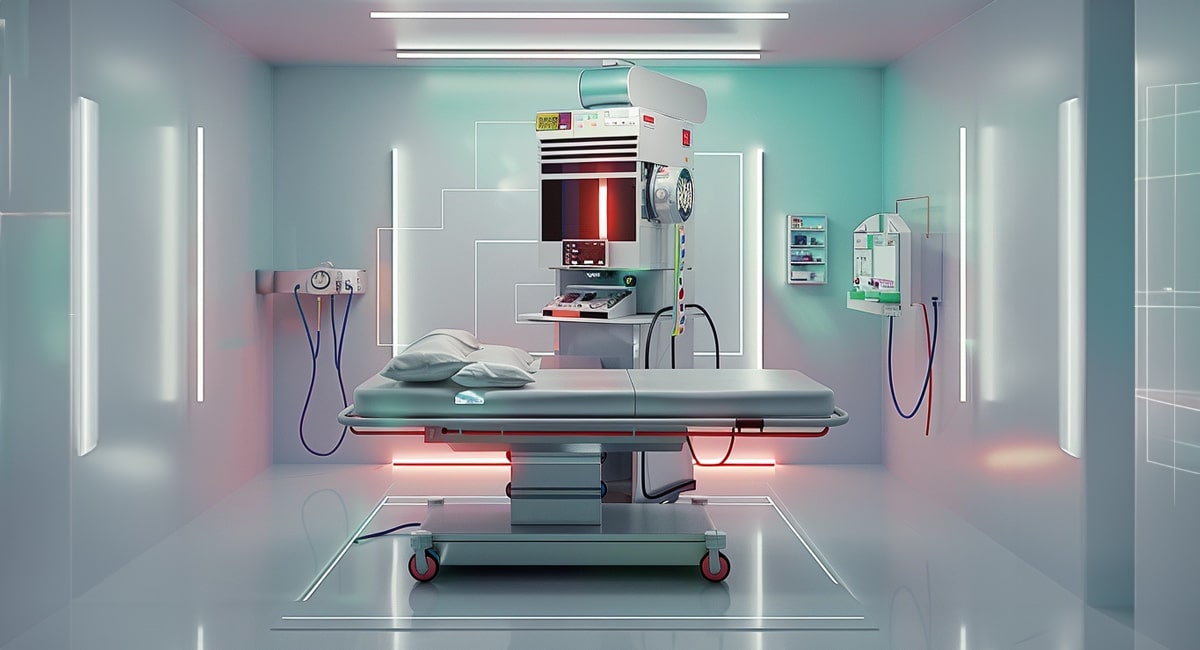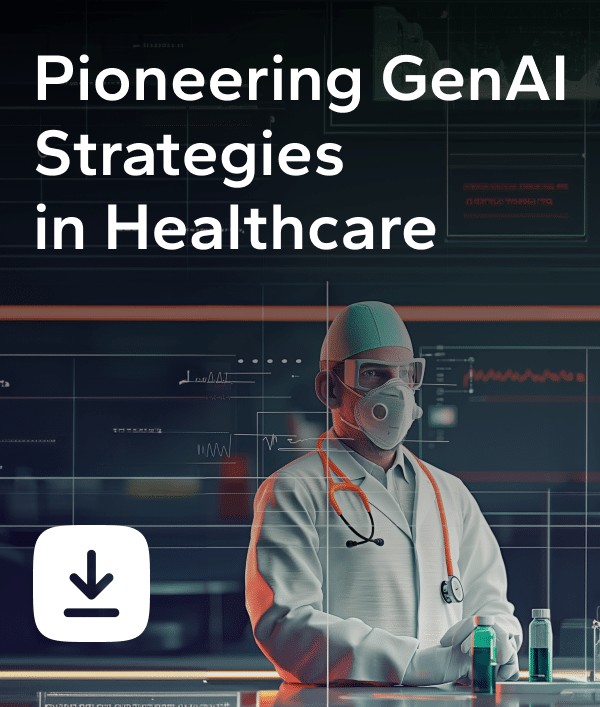It’s estimated that $1 trillion in healthcare spending is wasted each year in the U.S. By automating routine tasks and making more use of clinical data, GenAI is a new opportunity to optimize healthcare expenditures and unlock part of the money lost to inefficiencies. It could organize administrative disarray, reduce redundancies, and enhance the overall efficiency of healthcare services.
A report from McKinsey and Harvard researchers goes as far as to suggest that leveraging AI could save up to $360 billion a year in the U.S. alone.
However, the implementation of GenAI must be handled with care. Issues such as data privacy, security, and the need for an ethical framework to govern AI use be paramount in any GenAI health initiative. Healthcare providers must then ensure that, while they aim to cut costs and improve efficiency, they do not compromise on the quality of care or the trust and safety of their patients.
What is Generative AI
Generative AI, often called GenAI, processes large datasets to learn how to produce outputs that mimic the input data’s style and characteristics – text, images, and sounds. It brings forth a set of functionalities that are increasingly often used in various industries. GenAI’s capabilities extend to:
- Data Synthesis and Analysis: GenAI is great at ingesting and interpreting vast amounts of structured and unstructured data to produce coherent summaries and reports, and glean valuable insights.
- Content Generation: GenAI’s ability to autonomously generate high-quality, contextually appropriate content includes everything from writing promotional copy to coming up with detailed narratives and producing digital media.
- Automation of Repetitive Tasks: GenAI automates routine tasks, organizing processes such as customer service inquiries, administrative duties, and even complex programming tasks. This way, efficiency is boosted, and human talent can focus on more demanding activities.
- Realistic Simulations: Useful in fields ranging from architecture to virtual reality, GenAI can create detailed simulations and models that provide a sandbox for change without the high costs of physical prototypes. These applications are invaluable for design, training, and testing in safe, controlled environments.
History of AI in Healthcare
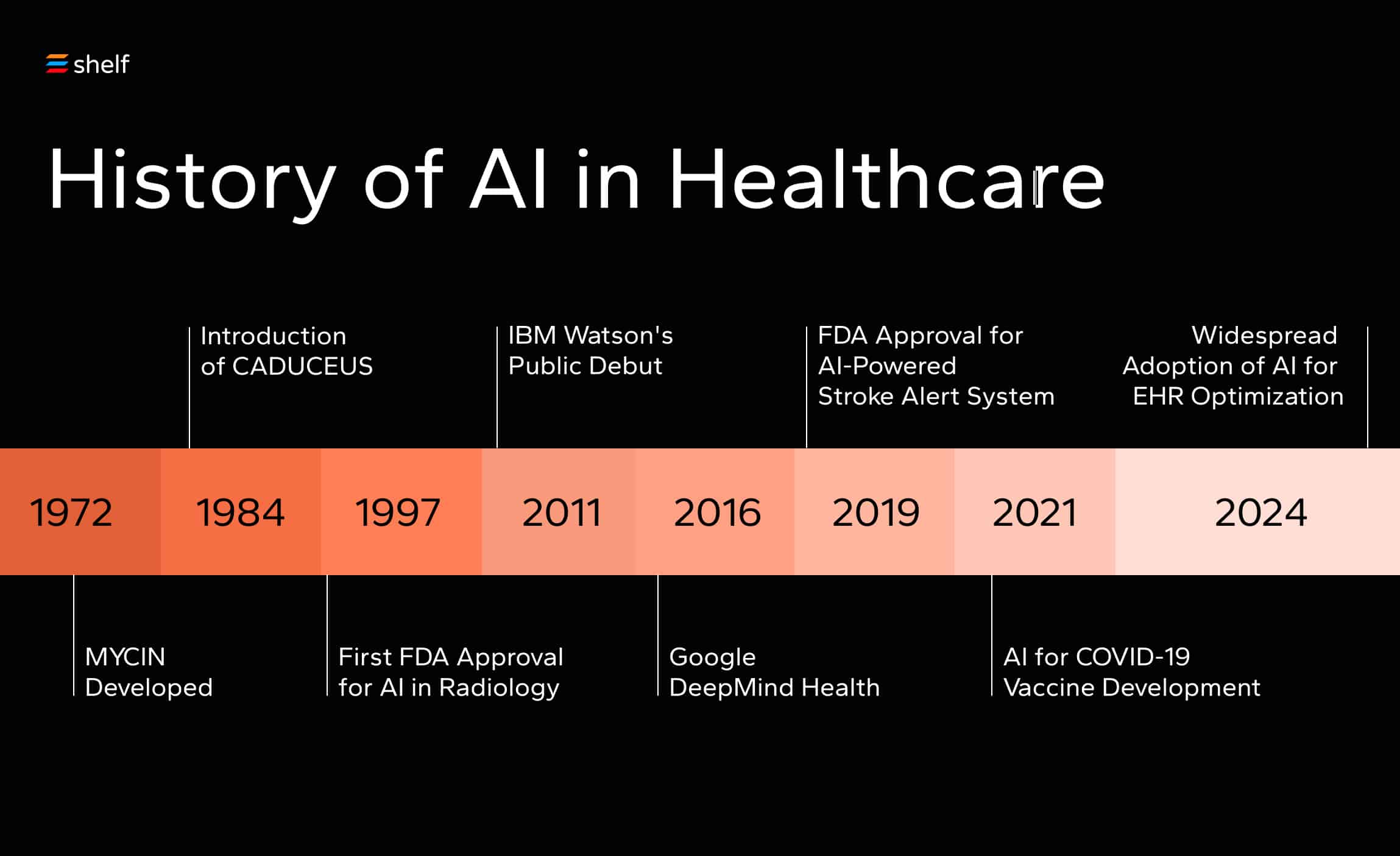
- 1980s: Emergence of Expert Systems – The inception of AI in healthcare was characterized by systems like MYCIN in the 1970s and 1980s, designed to emulate physician decision-making processes, particularly in infectious disease diagnosis and treatment.
- 1990s-2000s: Diagnostic Tools – As technology advanced, the focus shifted toward diagnostic aids. Notable developments included systems capable of analyzing complex medical data, such as IBM’s Watson, which was explored for oncology diagnostics in the late 2000s.
- 2010s: Proliferation of Machine Learning – The integration of machine learning during the 2010s revolutionized predictive analytics in healthcare. This decade saw the implementation of algorithms that could predict patient outcomes, optimize treatment plans, and enhance diagnostic accuracy through the analysis of medical images.
- 2020s: Advent of Generative AI – The current phase in AI development is dominated by generative models whose duty is not limited to assisting in operational tasks. They can go as far as to aid in drug discovery and patient management. These models have started to play a critical role in generating medical literature, simulating patient interactions, and automating content creation for clinical notes.
Growth of AI in Medical Devices
The 2020s also saw the continued exponential growth of FDA-authorized AI-enabled medical devices. In 2023, 171 new AI-enabled medical devices were added to the FDA list – that’s a 33% increase in authorizations in one year.
As of October 2023, there were 692 total devices on the FDA’s list:
- 531 devices in Radiology
- 71 devices in Cardiovascular
- 20 devices in Neurology
- 15 devices in Hematology
Generative AI Use Cases in Healthcare
Generative AI works optimally in settings with high predictability and minimal risk. In environments where errors carry less severe consequences, GenAI effectively identifies patterns and makes predictions from historical data. It adeptly manages routine patient information gathering and data summarization through conversational engagement, aligning well with the healthcare sector’s requirements for accuracy and routine data handling. The cautious approach allows healthcare providers to gradually integrate AI technologies, providing opportunities to refine these systems in less critical applications before full-scale implementation.
Operations
In healthcare, operational snags are as common as colds in the winter. GenAI can enhance administrative efficiency without adding more (human) work hours. Here’s how the operational aspects of healthcare are changing thanks to GenAI:
- Claims Management Reinvention: By automating the review and processing of claims, GenAI reduces the time spent on paperwork, minimizes human error, and ensures faster payouts. The AI-driven systems scan, extract, and process vast amounts of data, enabling quicker resolutions of claims and appeals.
- Scheduling and Resource Allocation: Forget the headache of manual scheduling. GenAI tools are quite useful for optimizing schedules, balancing workforce demands, and predicting patient inflows. This capability improves the utilization of resources and shortens patient wait times.
- Supply Chain Optimization: GenAI is a supply chain master that predicts disruptions and facilitates scenario analysis. By integrating data across networks, it ensures that medical supplies are efficiently managed, from order to delivery, enhancing both resilience and cost management.
- Administrative Workflows: Anyone who’s been entangled in healthcare administration can appreciate GenAI’s ability to act as an organizer. From patient registration to billing, GenAI systems help manage data entry, minimize redundancy, and ensure accuracy. This reduces the administrative burden on staff, allowing them to focus on what truly matters.
- Enhanced Communication: GenAI improves communication channels within healthcare settings. By automating call center operations and customer service, GenAI systems handle high call volumes, reduce waiting times, and personalize responses, thus boosting overall customer satisfaction.
Clinical Applications
From patient histories and diagnostic images to genetic profiles, GenAI is able to analyze extensive datasets much faster than a human ever could. At the same time, it drives a level of diagnostic accuracy that markedly amplifies care efficiency and patient outcomes.
What sets GenAI apart is its ability to deliver diagnostic insights and treatment plans tailored to individual patients. This is particularly groundbreaking in specialized areas like oncology, where GenAI evaluates potential treatment impacts on specific cancer types, enabling more targeted and effective therapy options.
Furthermore, GenAI is revolutionizing patient monitoring by integrating with sensors and wearable tech. This enables continuous, non-intrusive monitoring, providing healthcare professionals with real-time insights that can preempt critical situations – particularly valuable in post-operative care and chronic disease management.
Patient Interaction and Care
A potential patient is probably still better off not trying to diagnose themself, but the ability to make such an attempt is becoming more and more feasible. By clearing the way for real-time, intelligent communication, GenAI brings medical professionals and patients closer, making sure that high-quality, personalized healthcare goes beyond the confines of direct consultations.
While many of these steps are being developed as we speak, this narrative isn’t quite the reality yet. This example illustrates the promising potential of Generative AI (GenAI) in transforming patient care from start to finish. Imagine a future where Jane, a patient with a chronic heart condition, begins to experience unusual symptoms one evening.
- The Onset of Symptoms: Jane uses her health provider’s app, powered by GenAI, to describe her symptoms. The AI, trained on medical data, interprets her input and immediately provides preliminary advice. Recognizing potential red flags, it advises Jane to visit her nearest emergency room and automatically alerts the ER about her impending arrival, sharing her symptoms and medical history.
- Arrival and Treatment: Upon arrival, the ER team is prepared, having received a summarized briefing from the GenAI system. They quickly perform the necessary evaluations, guided by the AI’s preliminary analysis. Throughout her stay, the GenAI continues to assist the medical team by pulling up relevant medical data from her past, suggesting diagnostic tests, and predicting potential complications based on similar patient histories.
- Hospital Discharge and Home Care: Once stabilized, Jane is ready to be discharged. The GenAI system generates personalized discharge instructions, which include easy-to-understand explanations of her condition, medication schedules, and follow-up care, all tailored to her specific needs. It also schedules her follow-up appointments automatically and syncs them with her digital calendar.
- Ongoing Care and Monitoring: Back home, Jane continues to interact with the GenAI through her provider’s app. The system sends her daily check-in prompts, asking about specific symptoms and her general well-being. It adjusts her medication reminders based on her inputs and recovery progress. If Jane reports any concerning symptoms, the GenAI either offers immediate advice or escalates the issue by scheduling a telemedicine consultation with her doctor.
- Health Education and Support: To help Jane understand her condition better and manage her health proactively, GenAI curates personalized educational content, including articles, videos, and infographics about heart health. It also connects her to virtual support groups where she can share experiences and advice with other patients with similar conditions.
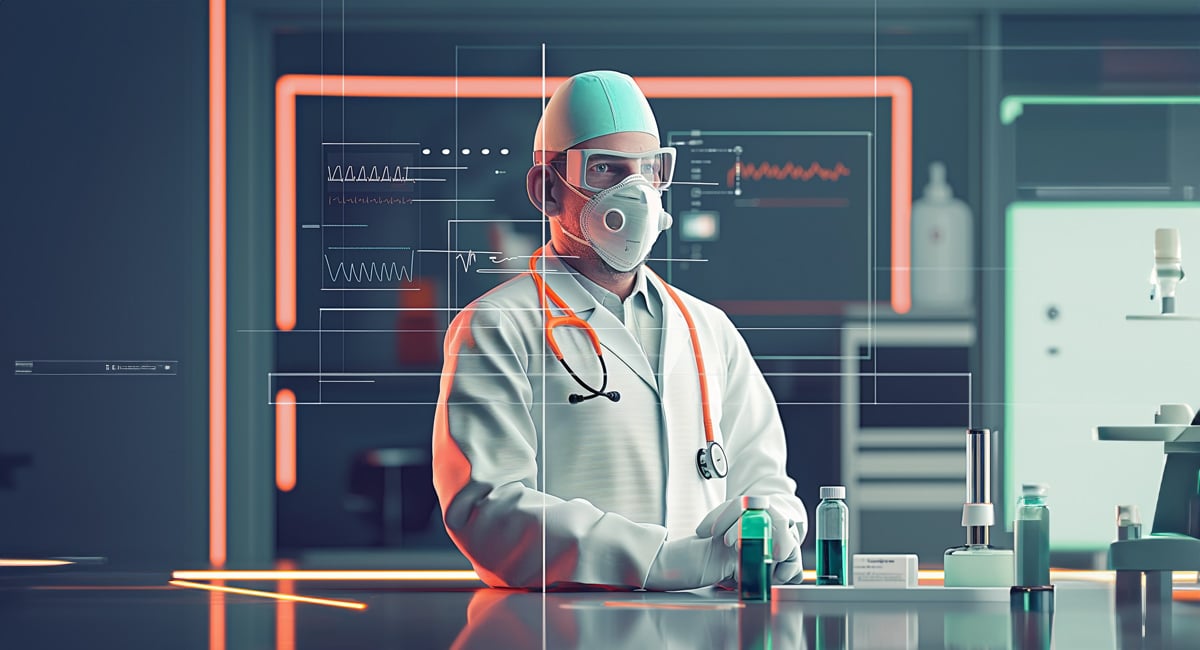
Unique Challenges of Generative AI in Healthcare
The integration of GenAI into healthcare is greeted with as much caution as enthusiasm, given the unique set of challenges that accompany its promising capabilities. These challenges span from operational hurdles to ethical considerations, each demanding a different strategy for mitigation.
HIPAA and Patient Data Privacy
The flood of patient data used with GenAI brings with it a deluge of privacy concerns. As the Health Insurance Portability and Accountability Act (HIPAA) sets stringent standards for the protection of sensitive patient data, the baseline of integrating GenAI means ensuring all generated and processed data comply with HIPAA regulations.
This includes securing data transmissions, encrypting data at rest, and implementing access controls. Any lapse, aside from risks of hefty fines and loss of certifications, could also erode the foundational trust patients place in their healthcare providers. Therefore, continuous risk assessments and updates to privacy policies are essential to stay ahead of potential vulnerabilities brought about by new AI functionalities.
Other Legal Regulations and Safety Concerns
It’s important to recognize that regulatory challenges don’t end with HIPAA and Patient Data Privacy. The broader regulatory framework extends into areas like AI system certification, clinical use, and interoperability. For instance, the Food and Drug Administration (FDA) oversees AI applications that qualify as medical devices, requiring strict testing before clinical use.
Other regions have their own frameworks. For instance, Canada’s PIPEDA protects personal information in the private sector, including healthcare, and Health Canada mirrors the FDA’s safety requirements for medical devices. In Asia, China’s New Generation Artificial Intelligence Development Plan sets broad AI strategies, including ethics and policies, while Singapore’s Model AI Governance Framework offers guidance for responsible AI deployment in healthcare.
Staying ahead of this dynamic regulatory environment requires healthcare organizations to be proactive rather than reactive. This involves regular engagement with regulatory bodies, participation in industry forums, and collaboration with legal experts who specialize in healthcare and technology law.
Safety Concerns
The safety of GenAI in healthcare doesn’t end in data privacy and regulatory issues. Misdiagnoses, inappropriate treatment suggestions, and other errors could have dire consequences, potentially risking patient health and safety. Given the stakes (human life itself!), the integrity of AI systems is something to be aware of at all times.
A ‘Human in the Loop‘ approach ensures that healthcare professionals verify and validate AI-generated outputs before any clinical action is taken. However, it also requires that healthcare providers are trained to work alongside GenAI.
Data Integrity and AI Hallucinations
Feeding GenAI systems poor-quality data can lead to what’s known as hallucinations — instances where AI generates false or misleading information. If such data is used in patient diagnosis or treatment planning, the consequences can be extremely serious, potentially leading to incorrect treatments or misdiagnoses.
Ensuring the accuracy of AI outputs requires rigorous data validation protocols. Data must be continuously cleaned and standardized before they reach the AI systems to minimize errors. Additionally, it’s crucial to monitor AI performance closely, addressing any deviations from expected results immediately.
Feedback from healthcare providers is also invaluable. Allowing them to report inaccuracies helps keep AI algorithms at their best, making them more reliable. Regular updates to AI models are essential as well, ensuring that systems stay current with the latest data and medical guidelines.
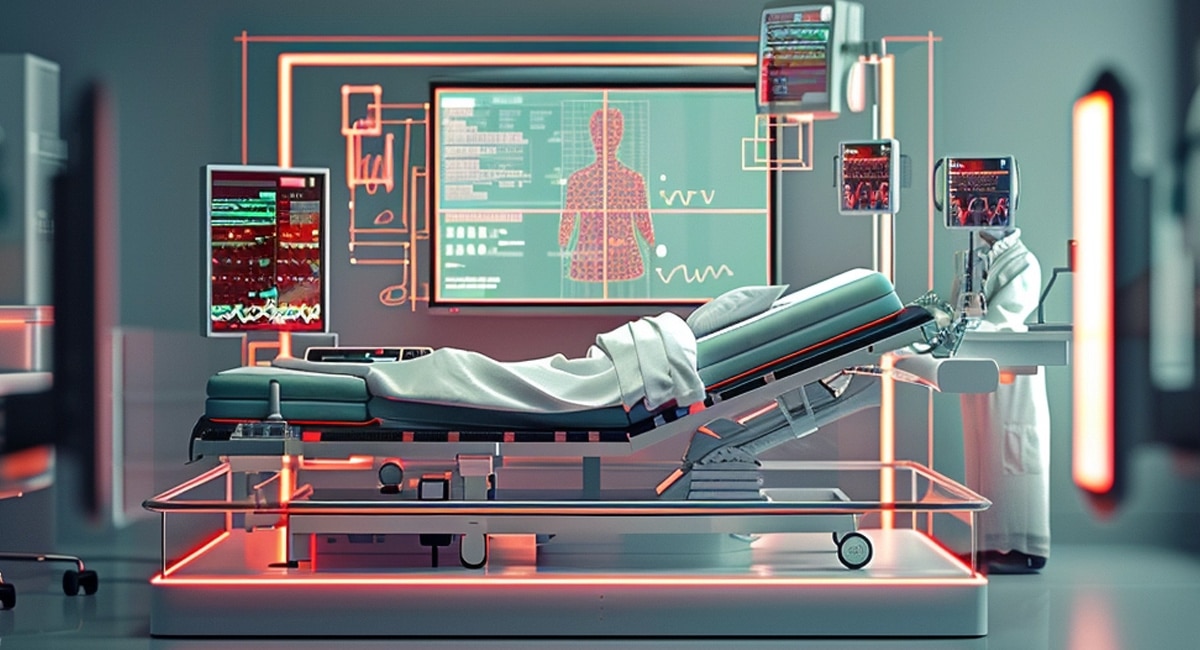
Ethical Implications of Generative AI in Healthcare
Responsibility
The integration of GenAI into healthcare raises profound ethical questions that go beyond technical and regulatory concerns. One of the most pressing issues is the allocation of responsibility for AI-driven healthcare decisions.
For instance, if a GenAI system recommends a treatment that leads to an adverse outcome, who is to be held accountable? Is it the developers who designed the AI, the healthcare providers who implemented the recommendation, or the system itself? Establishing clear guidelines for responsibility and accountability is crucial to ensure that ethical standards are maintained and that there is recourse in cases of error.
Transparency
Another significant ethical consideration is the nature of patient-AI interactions. As GenAI technologies become more involved in direct patient care, ensuring that these interactions uphold patient dignity and consent becomes essential. For example, should patients be informed when an AI system is involved in their diagnosis or treatment planning? How much should patients know about the AI’s capabilities and limitations? Ensuring transparency in patient-AI interactions can help build trust and allow patients to make informed decisions about their care.
Potential Bias
The potential for bias in AI algorithms presents another ethical challenge. AI systems are only as unbiased as the data they are trained on, and historical healthcare data can often reflect systemic biases related to race, gender, or socioeconomic status. For instance, if a GenAI system is trained primarily on data from a particular demographic, its recommendations may be less accurate for people outside of it.
The Future of GenAI in Healthcare
GenAI isn’t just a back-office booster; it’s set to redefine patient interactions, operational efficiencies, and much more, potentially unlocking billions in healthcare savings. But the journey towards this future isn’t set on autopilot.
The challenge lies not just in deploying GenAI but in doing so responsibly. As these systems take on more roles—from diagnosing diseases to managing patient data—the stakes are undeniably high. The allure of automation must be therefore balanced with vigilant oversight to ensure that innovations enhance, rather than compromise, patient care.
